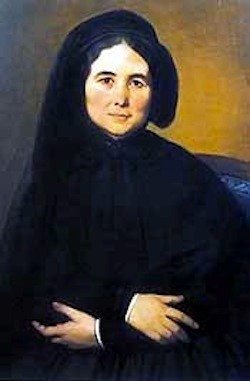Father Jean Gailhac, Founder and
Mother St. Jean Pelissier Cure, Foundress , and First Superior
Born in Béziers, France, on November 13, 1802, and ordained a priest in 1826, Jean Gailhac served as chaplain of the civil and military hospital in the city of Béziers where he became familiar with the needs of women who had become victims of a life of prostitution. Gailhac made arrangements for many of these women to be received in a shelter in Montpellier, paying their room and board from his own small salary. When he could no longer afford the fees, he founded in Béziers the work of the Good Shepherd, a shelter for women and very soon afterwards, an orphanage as well.
Eugène Cure and his wife Appollonie Pelissier Cure generously supported the many works of charity initiated by Gailhac. Born February 2, 1809, into a well-established family of Murviel-les-Béziers, Appollonie Pelissier grew up in a deeply Christian home. When her husband Eugene died in 1848, Appollonie offered herself and her financial resources towards the founding of the religious community already envisioned by Father Gailhac for the direction and service of the women’s shelter and orphanage of the Good Shepherd. On February 24, 1849, Appollonie moved to the Good Shepherd where she and five companions became the first members of the Religious of the Sacred Heart of Mary.
As co-foundress and first superior, Appollonie, now known as Mother St. Jean, worked closely with Father Gailhac and governed the Institute until her death. During her time as superior, the shelter for women was transformed into a preservation for young girls at risk, and a boarding school for girls was begun. As the young Institute took on a variety of works, Mother St. Jean emphasized the need to strengthen unity in the midst of this diversity.
The Constitutions of the new Institute received diocesan approval in 1850, pontifical recognition in 1873, and canonical approval in 1880. Mother St. Jean Pelissier Cure died on March 4, 1869. Father Jean Gailhac outlived the first two general superiors and died on January 25, 1890, at the age of 88.
INTERNATIONAL EXPANSION
One of the major gifts of the RSHM is our internationality. Our Constitutions remind us: “We may be sent anywhere in the world where the Institute recognizes a need. We seek to grow in that freedom which allows us to relinquish our security in order to be available for mission.” (#35) From the earliest days of the Institute, we journeyed to other countries: France 1849. . . Ireland 1870. . . Portugal 1871. . . England 1872. . . United States 1877. . . Brazil 1911. . . Spain 1911. . . Italy 1930. . . Wales 1939. . . Canada 1943. . . Colombia 1947. . . Mozambique 1952. . . Mexico 1954. . .Zimbabwe 1956. . . Zambia 1966. . . Mali 1971. . . Scotland 1971. . . East Timor 2012
Today, our mission is being carried out in France, Ireland, Portugal, England, United States, Brazil, Italy, Wales, Colombia, Mozambique, Mexico, Zimbabwe, Zambia, Scotland, and East Timor. Our mission is enriched as we collaborate with other religious congregations and the laity to ensure “that all may have life.”

